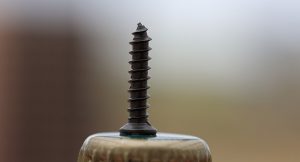
Screws are one of the most common types of fasteners. Consisting of a threaded shank with a head on the top and a tip on the bottom, they are used to secure multiple objects together. When shopping for screws, however, you may come across the terms “pitch” and “lead.” They are specifications that reflect certain physical characteristics of a given screw. What’s the difference between pitch and lead exactly?
What Is Pitch?
Pitch is a specification for the distance between each pair of individual threads. All screws have threading. Threading refers to the helical grooves or threads that extend from the head to the tip. Some screws are completely threaded, whereas others are partially threaded. Regardless, all screws have at least some threading.
The distance between two adjacent threads is the pitch. Screws with wide threads — meaning the threads are far apart from each other — will have a higher pitch than those with narrow threads.
What Is Lead?
Lead is a specification for the travel distance of a screw after a complete revolution. In other words, it reflects how far a screw will travel after being turned 360 degrees.
Some screws will travel farther when turned 360 degrees than others. You can gain a better understanding of a screw’s travel distance by inspecting its lead. Lead is the distance that a screw will travel after a full and complete revolution. Screws with a high lead will travel farther than those with a low lead.
Differences Between Pitch and Lead
You’ll need to consider more than just the size and head type when choosing screws. Other specifications to consider include pitch and lead. Pitch is the distance between a screw’s threads, whereas lead is the distance a screw will travel when turned 360 degrees.
As previously mentioned, all screws have threading. The way in which the threading is designed can affect both the pitch and lead. Pitch is simply a measurement of the distance between the threads. Lead, conversely, is a measurement of how far a screw will travel after a complete revolution.
It’s important to note that some screws have the same pitch and lead. Known as single start screws, the pitch and lead are equal to each other. Other types of screws have a different pitch and lead. This is why it’s a good idea to check these specifications when shopping for screws.
